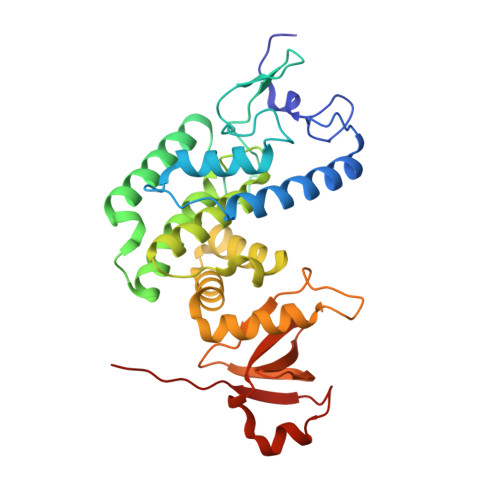Fic Domain Catalyzed Adenylylation: Insight Provided by the Structural Analysis of the Type Iv Secretion System Effector Bepa.
Palanivelu, D.V., Goepfert, A., Meury, M., Guye, P., Dehio, C., Schirmer, T.(2011) Protein Sci 20: 492
- PubMed: 21213248
- DOI: https://doi.org/10.1002/pro.581
- Primary Citation of Related Structures:
2JK8, 2VY3, 2VZA - PubMed Abstract:
Numerous bacterial pathogens subvert cellular functions of eukaryotic host cells by the injection of effector proteins via dedicated secretion systems. The type IV secretion system (T4SS) effector protein BepA from Bartonella henselae is composed of an N-terminal Fic domain and a C-terminal Bartonella intracellular delivery domain, the latter being responsible for T4SS-mediated translocation into host cells. A proteolysis resistant fragment (residues 10-302) that includes the Fic domain shows autoadenylylation activity and adenylyl transfer onto Hela cell extract proteins as demonstrated by autoradiography on incubation with α-[(32)P]-ATP. Its crystal structure, determined to 2.9-Å resolution by the SeMet-SAD method, exhibits the canonical Fic fold including the HPFxxGNGRxxR signature motif with several elaborations in loop regions and an additional β-rich domain at the C-terminus. On crystal soaking with ATP/Mg(2+), additional electron density indicated the presence of a PP(i) /Mg(2+) moiety, the side product of the adenylylation reaction, in the anion binding nest of the signature motif. On the basis of this information and that of the recent structure of IbpA(Fic2) in complex with the eukaryotic target protein Cdc42, we present a detailed model for the ternary complex of Fic with the two substrates, ATP/Mg(2+) and target tyrosine. The model is consistent with an in-line nucleophilic attack of the deprotonated side-chain hydroxyl group onto the α-phosphorus of the nucleotide to accomplish AMP transfer. Furthermore, a general, sequence-independent mechanism of target positioning through antiparallel β-strand interactions between enzyme and target is suggested.
Organizational Affiliation:
Core program of Structural Biology and Biophysics, Biozentrum, University of Basel, CH-4056 Basel, Switzerland.















